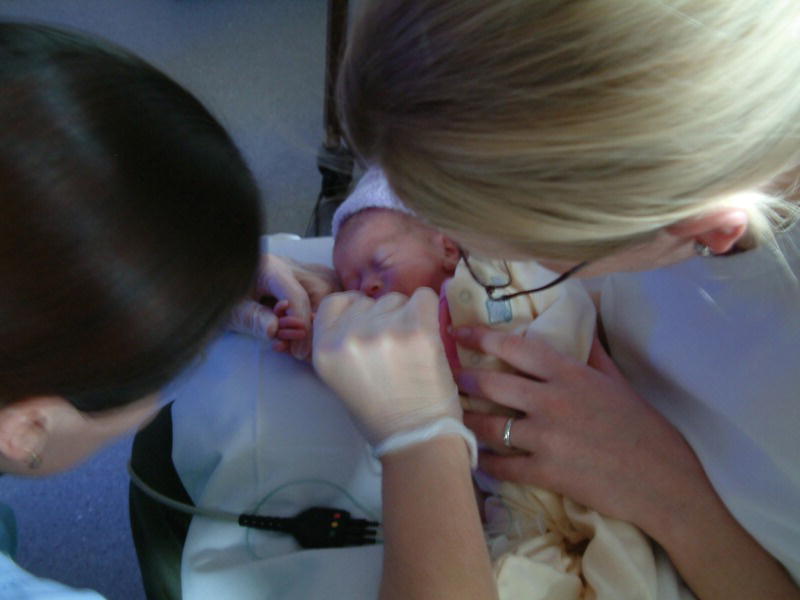63
Pain
Pain is a subjective cortical experience. Newborn infants cannot describe a painful experience, but there is good evidence from physiologic and behavioral responses that they respond to pain and it causes distress (Table 63.1). Pain is one of the main parental concerns for infants in intensive care or undergoing procedures. Parents often also worry about long-term consequences. There is evidence that children who undergo repeated painful experiences as neonates show increased sensitivity to pain in childhood, e.g. to an immunization, and are more fearful of pain than their peers.
Table 63.1 Some early milestones in neonatal pain.
| 1987 | Proven that surgical thoracotomy for PDA ligation caused greater physiologic and hormonal disturbance if performed without analgesia |
| 2000 | American Academy of Pediatrics Policy Statement on Prevention and Management of Pain and Stress in the Neonate. Updated 2006 |
| 2001 | International Consensus Statement for the Prevention and Management of Pain in the Newborn |
Development of pain pathways in the fetus and preterm infant
Pain pathways are well described in the fetus:
- 20 weeks – sensory receptors and cortical neurons have developed
- 24 weeks – cortical synapses are present
- 30 weeks – myelination of pain pathways and development of spinal cord synapses with sensory fibers.
This implies that even preterm infants have anatomic, neurophysiologic and hormonal components to perceive pain. Central descending inhibitory control is less well developed – so response to painful stimuli is actually greater than in older children and adults.
Factors that modify pain responses
Infants requiring intensive care are subjected to an average of 2–10 painful procedures per day. They are also repeatedly disturbed, e.g. for examination, nursing care.
The pain they experience will be affected by:
- procedure being performed (Fig. 63.1), the skill of the operator and their concern about minimizing discomfort
- gestational age and postnatal age
- behavioral state
- number of previous painful experiences
- time since last painful experience
- severity of their illness.

Fig. 63.1 Postulated hierarchy of pain from procedures.
(Adapted from Porter F. et al. Procedural pain in newborn infants: the influence of intensity and development. Pediatrics 1999; 104: 1–10.)
Assessment of pain
Pain can be assessed clinically according to:
- Physiologic responses:
- – heart rate, respiratory rate, oxygen requirement, blood pressure, palmar sweating.
- Behavioral responses:
- – facial expression, body movements, crying.
- Metabolic responses:
- – stress hormones, e.g. cortisol
- – blood glucose, lactate.
These may be used as proxy measures of pain. Obtaining reliable results is problematic and their interpretation is difficult.
Pain assessment scales
A variety of neonatal pain assessment scales have been developed (Table 63.2), mainly for clinical research or postoperative pain assessment (CRIES, NFCS, PIPP scores). The simpler scales can also be used for regular, systematic pain assessment for infants undergoing intensive care, or as guidance for staff on pain assessment (NPASS).
Table 63.2 Some validated pain assessment scales in newborn and preterm infants.
| Neonatal Pain, Agitation and Sedation Scale (NPASS) | Premature Infant Pain Profile (PIPP) | Neonatal Facial Coding Scale (NFCS) | CRIES score |
Behavioral cues:
|
Gestational age Behavioral state Brow bulge Eye squeeze Nasolabial furrow Heart rate Oxygen saturation |
Brow bulge Eye squeeze Nasolabial furrow Open lips Stretch mouth Lip purse Taut tongue Chin quiver Tongue protrusion |
Crying Requires increased oxygen Increased vital signs Expression Sleeplessness |
Minimizing pain
There are both non-pharmacologic and pharmacologic approaches. Always consider:
- Is the procedure really necessary?
- Timing the procedure for when the infant is awake, if possible.
- Grouping procedures together, but limit the number of procedures occurring within a short time of each other (as with physical training, we all need recovery time!).
- Using equipment or methods designed to minimize discomfort (e.g. appropriately sized heel lancets, non-invasive monitoring, venous or arterial catheters to avoid repeated skin punctures, avoiding intramuscular injections).
Non-pharmacologic
These include:
- Environmental modification:
- – quiet, low lighting, talking to baby, slow stroking, rocking, skin-to-skin contact.
- Non-nutritive sucking on a pacifier (dummy) or sucking on breast.
- Sucrose and breast milk both reduce pain responses.
- Positioning on side, swaddling, comfort holding with still hands (Fig. 63.2).

Fig. 63.2 Containing the infant helps reduce pain. This involves secure, supported, non-restrictive positioning, not tight swaddling to prevent moving. Here, during the insertion of a nasogastric tube, the mother is containing her baby and the infant is grasping the nurse’s finger.
Pharmacologic approaches
Infants on mechanical ventilation
Use of analgesic/anesthetic agents differs between units. The most widely used are:
- morphine – side-effects include hypotension, respiratory depression and withdrawal syndrome if there is a too rapid dose reduction after prolonged use
- fentanyl – side-effects include respiratory depression, tolerance, occasionally tongue and chest wall rigidity.
Procedures
Optimal analgesia aims to prevent rather than treat pain. In the past, fear of side-effects limited the use of opioids and anesthetic agents, but it should now be possible to provide adequate pain relief, especially postoperatively. Options include:
- Opioids –continuous opioid infusion is preferable as intermittent boluses are associated with poor outcome.
- General anesthesia – all major or surgical procedures.
- Regional anesthesia – e.g. peripheral nerve blocks, spinal or epidural, local infiltration, e.g. for chest tube insertion.
- Non-opioids – e.g. acetaminophen (paracetamol); sometimes used for minor procedures or postoperatively.